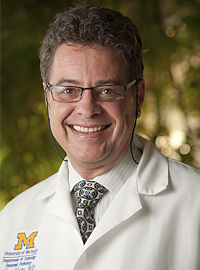Frontline Workers in the Backrooms of COVID-19: Caring for the Living and the Dead
By Camren Clouthier | June 18 2020A new article in the American Journal of Clinical Pathology focuses on the response to the COVID-19 pandemic in a forensics center that integrates an academic department of pathology with multiple regional county medical examiners’ offices.
 The publication, co-authored by Dr. Jeffrey Myers, reflects on several key points, including how an investment in a cross-functional forensics center that combines an academic medical center and regional medical examiners’ office is important for navigating a pandemic, why forensic pathology is an essential public health service for recognizing emerging diseases, defining novel diseases, and providing objective data to inform responses to current and future pandemics, and why forensic pathology is a model for patient and family-centered care.
The publication, co-authored by Dr. Jeffrey Myers, reflects on several key points, including how an investment in a cross-functional forensics center that combines an academic medical center and regional medical examiners’ office is important for navigating a pandemic, why forensic pathology is an essential public health service for recognizing emerging diseases, defining novel diseases, and providing objective data to inform responses to current and future pandemics, and why forensic pathology is a model for patient and family-centered care.
The focus of the first segment is the impact of forensic pathology as a public health service to local communities. Myers recounts the creation of the autopsy and forensic center at the University Hospital in 2008, led by Drs. Jeffrey Jentzen, Allecia Wilson, and Carl Schmidt. Fast forward to present day and the forensic pathology program has proven critical in supporting local counties and families of both COVID-19 patients and others who died at home and in hospitals. Furthermore, Myers indicates that the pandemic has had a profound impact on hospital-based morgues and medical examiner offices in hot spots across the country. Despite the circumstances, all decedents at Michigan Medicine were treated with respect and dignity by experienced and dedicated autopsy personnel whose volunteerism mirrored the dedication and commitment of other frontline health care workers.
In the second segment, the story discusses the impact of forensic pathology and partnering with both families and providers in order to care for the living. Initially, the pandemic created several new challenges, one of the largest being the inability for families to visit their loved ones - alive or deceased - in the hospital facilities. "Many of these families expressed pain and guilt for not being able to say a final goodbye to their loved one," Myers notes. However, the autopsy and forensics team was able to adapt quickly and eventually substituted photographs for in-person viewings as a way to better comfort families grieving the loss of a loved one. One grieving father replying to an email sent in response to his request for photographs said, “having these helps [me] considerably.”
Myers continues by highlighting the importance of the patient's relationship with their pathologist. Redesigning health care systems should involve structures to support and facilitate conversations between patients, their families, and pathologists.
"All patients deserve dignity and respect, whether alive or deceased; when a patient dies that respect is due their families who serve as the custodians of their wishes and shepherds of their dignity."
Ultimately, while increased deaths due to COVID-19 certainly challenged the capacity limits of the hospital morgue and medical examiner’s office, the forensics team sucessfully managed and navigated the challenges they endured. Autopsies of suspected and proven cases of COVID-19 were later performed in both facilities. Scene investigators worked directly with families to meet needs unique to the pandemic and artful photographs of decedent’s hands and/or tattoos were offered to those unable to have in-person viewings. Pathologists and social workers were available to families of the deceased and created novel solutions to facilitate the grieving process. "Direct conversations with pathologists empower patients and their families," Myers concludes.
The full publication in the American Journal of Clinical Pathology is accessible here. The Deeper Levels podcast, featuring Dr. Myers, is accessible here.
 ON THE COVER
ON THE COVER
 ON THE COVER
ON THE COVER
 ON THE COVER
ON THE COVER
 ON THE COVER
ON THE COVER
 ON THE COVER
ON THE COVER
 ON THE COVER
ON THE COVER
 ON THE COVER
ON THE COVER
 ON THE COVER
ON THE COVER
 ON THE COVER
ON THE COVER
 ON THE COVER
ON THE COVER
